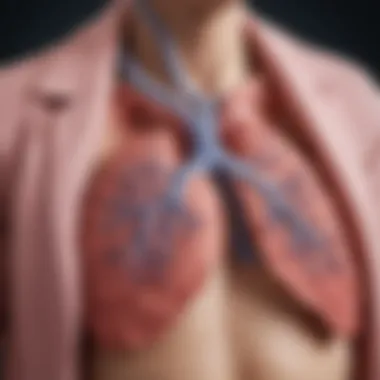Exploring Broncho Pulmonary Dysplasia in Infants


Intro
Broncho pulmonary dysplasia (BPD) is a serious lung condition that primarily affects premature infants. This disorder arises when infants need assistance with breathing and oxygen due to underdeveloped lungs. As the baby’s lungs undergo treatment and repair, they may also experience inflammation and scarring, which exacerbate their respiratory status.
This condition was first identified in the 1960s, and it has since been recognized as a significant complication for those born before 28 weeks of gestation. Advances in neonatal care have improved outcomes for these vulnerable infants, but BPD remains a challenging issue. The complexity of this disorder, combined with its impact on infant health, necessitates a deep exploration of its underlying causes, symptoms, treatment methods, and potential long-term effects.
Intro to Broncho Pulmonary Dysplasia
Broncho pulmonary dysplasia (BPD) represents a significant concern in neonatal medicine, particularly for premature infants. This condition can influence not just lung health but also broader aspects of growth and development. Understanding BPD is essential not just for healthcare providers but also for researchers and educators in the field of pediatric medicine.
BPD arises from injury to the lungs, often as a consequence of mechanical ventilation and oxygen use to support premature infants with underdeveloped lungs. Hence, a thorough comprehension of its mechanisms helps in formulating effective prevention strategies and management protocols. In this introductory section, we will outline the definition of BPD and its clinical implications – essential knowledge for anyone involved in neonatal care.
Definition and Overview
Broncho pulmonary dysplasia is usually described as a chronic lung disease that affects newborns. Most commonly, it occurs in infants who are born before 28 weeks of gestation and those who have low birth weight. The condition is characterized by a need for supplemental oxygen and respiratory support after the initial neonatal period.
BPD is not merely a single entity but a spectrum of clinical presentations, ranging from mild to severe forms. Clinically, chest radiographs may reveal hyperinflation and atelectasis, and such findings correlate with the severity of the disease.
Major factors contributing to the development of BPD include:
- Ventilator-induced injury: Excessive pressure or volume can damage vulnerable lung tissue.
- Oxygen toxicity: High levels of oxygen can lead to further lung injury.
These factors interplay in a complex manner, emphasizing the need for multifaceted intervention strategies.
Historical Context
The history of broncho pulmonary dysplasia dates back to the mid-20th century. The term was first reported in 1967 by Northway et al., who described a syndrome in premature infants. Initially, the condition attracted attention as neonatal intensive care units started using mechanical ventilation in greater numbers. Over the years, improvements in care practices have evolved, causing changes in the incidence and severity of BPD.
As medical interventions progressed, so too did the understanding of the underlying biology of lung development and injury. The protocols adopted in neonatal units today continually strive to minimize lung injury while addressing the respiratory needs of premature infants. This evolution underlines the necessity of an ongoing dialogue within the medical community to adapt and implement better treatment practices.
"Understanding the historical evolution of BPD is crucial for improving current management strategies and patient outcomes."
In summary, the exploration of broncho pulmonary dysplasia serves to shed light on an important and complex health issue. Fostering a deeper understanding of BPD can ultimately lead to improved care practices and better clinical outcomes for vulnerable populations.
Epidemiology
Epidemiology plays a critical role in understanding broncho pulmonary dysplasia (BPD). It investigates the distribution, patterns, and determinants of the condition across various populations. By pinpointing the groups most at risk, healthcare professionals can tailor interventions effectively. This section explores the prevalence rates and risk factors associated with BPD.
Prevalence Rates
Research indicates that BPD affects approximately 30% to 40% of infants born weighing less than 1,500 grams. This condition is significantly more common among premature infants, particularly those birthed before 28 weeks of gestation. The prevalence of BPD has remained notably steady across years, although variations may occur due to advancements in neonatal care. Identifying these rates is vital as it helps in allocating resources and formulating preventive strategies targeted at high-risk groups.
Risk Factors
Several factors increase the likelihood of developing broncho pulmonary dysplasia. Understanding these enhances the capacity to mitigate them.
Gestational Age
Gestational age refers to the duration of pregnancy. Infants born prematurely are at a higher risk for BPD. Those born before 28 weeks are particularly vulnerable. Their lungs are often immature, and they may require intensive ventilation support. This aspect of gestational age is crucial in identifying infants who may benefit from immediate monitoring and intervention. An important characteristic is that more severe cases frequently arise with decreased gestation.
Birth Weight
Birth weight is another significant risk factor. Low birth weight is closely connected to the development of BPD. Infants weighing less than 1,000 grams face the most considerable risk. This category is a notable focus because the implications of weight affect the infants' ability to recover properly. Increases in birth weight might correlate with lower incidences of BPD, making it a point of interest in neonatal care strategies.
Environmental Exposures
Environmental exposures encompass various factors, such as secondhand smoke, air pollution, and inadequate prenatal care. These elements contribute to lung injury and inflammation, which are detrimental to vulnerable infants. The distinctive aspect of environmental exposures is that they are modifiable. Focusing on these exposures can lead to effective public health interventions, improving outcomes for at-risk populations.
Understanding the epidemiology of broncho pulmonary dysplasia is paramount for developing effective prevention strategies and enhancing patient care.


Etiology of Broncho Pulmonary Dysplasia
Understanding the etiology of broncho pulmonary dysplasia (BPD) is crucial to comprehending this condition's complexity. The mechanisms behind BPD provide insights into its onset and progression. Knowledge of the etiology helps in identifying risk factors and tailoring management strategies. Addressing these factors can significantly influence outcomes for premature infants, who are the most affected by this condition.
Mechanical Ventilation
Mechanical ventilation plays a significant role in the development of BPD. Premature infants often require respiratory support due to immature lung function. However, the use of mechanical ventilation can introduce mechanical stress to the fragile lung tissue. This stress may result in injury to the alveoli, leading to inflammation and disruption of normal lung development.
Research finds that high ventilator pressures can damage the delicate structures in the lungs. Reducing reliance on mechanical ventilation is a priority in minimizing BPD risk. Methods such as non-invasive ventilation techniques are being studied to limit lung injury while providing necessary respiratory support.
Important Insight: The balance between necessary respiratory support and the risks associated with mechanical ventilation is a critical area of focus in BPD management.
Oxygen Toxicity
Oxygen therapy, while essential for maintaining sufficient oxygen levels in premature infants, can also contribute to the etiology of BPD. Oxygen is required to prevent hypoxia, but excessive exposure can lead to oxygen toxicity. This occurs when high concentrations of oxygen interact with lung tissue, causing oxidative stress.
Oxidative stress can damage cellular structures and exacerbate lung injury. It is crucial to monitor oxygen levels carefully and use the lowest effective concentrations. Understanding oxygen toxicity's role provides pathways for developing safer treatment protocols that minimize lung damage while supporting infants’ respiratory needs.
Inflammatory Response
The inflammatory response is another vital aspect in the etiology of BPD. When the lungs are injured, an intricate cascade of inflammatory processes is triggered. Cytokines and inflammatory cells accumulate, further damaging the lung tissue. This inflammatory process is significantly influenced by factors such as mechanical ventilation and oxygen toxicity.
Chronic inflammation can impede the normal development of the lungs, leading to long-lasting effects. Understanding the role of inflammation can inform treatment decisions. Therapies aimed at modulating inflammatory responses are being explored to mitigate the progression of BPD.
In summary, the etiology of broncho pulmonary dysplasia highlights the interplay between mechanical factors, oxidative stress, and inflammatory processes. Recognizing these elements is important for developing effective interventions and preventive strategies.
Pathophysiology
Understanding the pathophysiology of broncho pulmonary dysplasia (BPD) is crucial for grasping how this condition develops and progresses. It elucidates the complex processes that unfold in the lungs of susceptible premature infants. This knowledge helps in the formulation of effective management strategies and in predicting long-term outcomes for affected individuals.
Lung Development and Injury
Lung development is a dynamic process that occurs during gestation. In preterm infants, the lungs may not fully mature, which impedes effective gas exchange. When these infants require mechanical ventilation or supplemental oxygen, the risk of lung injury increases significantly.
Injuries can arise from barotrauma due to excessive pressures used in ventilators. Additionally, volutrauma, which occurs when over-distention of the alveoli happens, may further exacerbate lung damage. These injuries lead to inflammation, which is a hallmark of BPD. Inflammatory mediators disrupt the normal lung development process. Consequently, the lungs may exhibit impaired alveolar and vascular growth. This impaired development can result in a reduced number of functional alveoli, affecting oxygen absorption and carbon dioxide elimination.
Alveolar and Vascular Development
The formation of alveoli and the associated vascular network is essential for normal respiratory function. Normally, alveoli multiply and expand after birth. However, in cases of BPD, this alveolar development is stunted. Reduced alveolar number results in fewer sites for gas exchange. Along with this alveolar reduction, the pulmonary blood vessels may also experience abnormal development.
Proper vascular development is critical for maintaining adequate blood flow through the lungs. This lack of proper vascularization contributes to pulmonary hypertension, a common complication in BPD. The interplay between abnormal alveolar and vascular development underscores the pathophysiological complexity of BPD.
This condition not only affects immediate respiratory health but can lead to significant long-term complications, impacting the overall quality of life for affected infants as they grow.
In summary, the pathophysiology of broncho pulmonary dysplasia involves intricate mechanisms of lung injury and abnormal development. Understanding these aspects is essential for optimizing care and improving outcomes for vulnerable populations.
Clinical Manifestations
Understanding the clinical manifestations of broncho pulmonary dysplasia (BPD) is critical for effective management and treatment of affected infants. This section explores how recognizing these signs and symptoms can guide clinicians in timely diagnosis and foster appropriate interventions to improve outcomes.
Signs and Symptoms
BPD presents with a range of signs and symptoms, which can vary depending on the severity of the condition. Common indicators include:
- Tachypnea: An increased respiratory rate is often one of the earliest signs noted in affected infants.
- Grunting: This noise, made during exhalation, indicates respiratory distress and may be present alongside other symptoms.
- Retracting: Visible pulling of the chest wall during inhalation can be a sign of respiratory effort.
- Cyanosis: A bluish tint to the skin indicates insufficient oxygenation and can necessitate immediate medical attention.
- Oxygen requirement: Infants may need supplemental oxygen to maintain adequate levels.
The combination of these symptoms suggests compromised lung function. Early identification is essential as it allows healthcare providers to intervene promptly and adjust care plans accordingly.
Differential Diagnosis
When diagnosing BPD, it is crucial to differentiate it from other respiratory conditions. Several similar disorders share overlapping symptoms. Key differential diagnoses include:


- Respiratory Distress Syndrome (RDS): Caused by surfactant deficiency, it primarily affects premature infants and must be distinguished from BPD.
- Pneumonia: Infectious processes in the lung can present similarly, highlighting the need for imaging and laboratory evaluations.
- Aspiration Syndromes: The inhalation of foreign substances can mimic BPD in presenting symptoms.
- Chronic Lung Disease: Conditions that result in prolonged respiratory issues should also be considered in differential diagnosis.
Clinicians must take a thorough history and conduct appropriate diagnostics, including imaging studies and laboratory assessments, to establish a clear diagnosis. Correctly identifying BPD as opposed to similar conditions is vital for implementing an effective treatment protocol and ensuring the better health of the infant.
"The early recognition of clinical manifestations not only paves the way for effective management but also substantially enhances the long-term outcomes for infants suffering from broncho pulmonary dysplasia."
In summary, familiarity with the clinical manifestations of BPD, emphasizing prompt detection and diagnosis, can significantly influence treatment effectiveness and overall prognosis.
Diagnosis
Diagnosis of Broncho Pulmonary Dysplasia (BPD) is pivotal in managing and treating the condition effectively. Correct identification and classification of BPD can guide clinical decisions that improve outcomes for infants affected by this disorder. Physicians and healthcare professionals use various diagnostic techniques to determine the presence and severity of this lung condition.
Diagnostic Criteria
Diagnostic criteria for BPD include consideration of clinical history, physical examination findings, and specific requirements related to oxygen therapy. The principal definition of BPD involves the need for supplemental oxygen or mechanical ventilation beyond a certain postnatal age, typically 28 days.
The main factors in the diagnosis are:
- Gestational Age: Diagnosis typically applies to premature infants born before 32 weeks of gestation.
- Oxygen Requirement: The need for respiratory support is assessed. Infants who require oxygen past 28 days of life are categorized as having BPD.
- Radiologic Evaluation: Chest radiographs usually show characteristic patterns consistent with lung injury and overdistension of alveoli.
By utilizing these criteria, healthcare professionals can systematically assess the likelihood of diagnosis and begin treatment plans promptly.
Imaging Techniques
Imaging techniques play a crucial role in the diagnosis of BPD. They help visualize lung architecture and identify any pathological changes. The most commonly used imaging modalities are:
- Chest X-ray: Often the first step in assessing lung health. This imaging can reveal changes in lung volume, fluid accumulation, and the state of the air spaces.
- Ultrasound: While not as common for BPD, chest ultrasound can sometimes assist in evaluating pleural effusions or other complications.
- CT Scan: In specific cases, a high-resolution computed tomography scan might be considered, providing detailed images of lung structure, which can identify issues not visible on a standard X-ray.
"Early recognition of BPD is key for implementing effective management strategies, as the disease can significantly impact long-term respiratory health."
These imaging techniques, in conjunction with clinical evaluations, offer comprehensive insights that facilitate accurate diagnosis and help formulate an effective treatment plan for affected infants.
Management and Treatment
Effective management and treatment of broncho pulmonary dysplasia (BPD) is crucial for improving outcomes in affected infants. Understanding the multifactorial aspects of this condition helps in designing comprehensive care strategies. The goal is to minimize lung injury, optimize respiratory function, and support overall growth and development. An integrated approach that combines preventive strategies, medications, and supportive care is essential for mitigating the complications associated with BPD.
Preventive Strategies
Preventive measures play a vital role in reducing the incidence and severity of BPD. Strategies should begin even before birth, focusing on maternal health and reducing risk factors. Key elements include:
- Antenatal Corticosteroids: Administering steroids to mothers at risk for premature delivery can enhance fetal lung maturity, thus decreasing the likelihood of developing BPD.
- Avoiding Premature Birth: Implementing effective management during pregnancy to prevent preterm labor is essential. This includes regular prenatal care and addressing relevant medical conditions.
- Optimal Nutrition: Ensuring appropriate nutritional support both prenatally and postnatally can aid lung development. Higher caloric intake may contribute to better growth and respiratory outcomes.
By addressing these factors, healthcare providers can significantly impact the risk of BPD in premature infants.
Medications
Pharmacological interventions are utilized to manage symptoms and promote lung health in infants diagnosed with BPD. Commonly used medications include:
- Bronchodilators: These medications help relax the muscles of the airways, making it easier for the infant to breathe. They may improve lung function and oxygenation.
- Diuretics: To manage fluid overload and pulmonary edema, diuretics such as furosemide may be prescribed. This treatment helps relieve respiratory distress caused by excessive fluid in the lungs.
- Steroids: In some cases, inhaled corticosteroids might be used to reduce inflammation in the airways, thus improving respiratory status.
Overall, the choice of medication must be individualized based on the infant's specific needs and clinical condition, keeping in mind the potential side effects and long-term implications.
Supportive Care
Supportive care is integral to the management of infants with BPD. It encompasses a range of interventions that aid in optimizing respiratory function and overall health. Important aspects include:
- Respiratory Support: Mechanical ventilation or supplemental oxygen might be necessary for infants who cannot maintain adequate oxygen levels. Non-invasive support methods, such as CPAP or high-flow nasal cannula, are preferred to minimize additional lung injury.
- Nutritional Support: Feeding strategies often require modification. Providing adequate caloric intake, whether through parenteral nutrition or specialized formula, is critical for growth and development.
- Monitoring and Follow-up: Regular follow-ups and monitoring of respiratory status are essential. Identifying any signs of deterioration or complications allows for timely intervention.
"The complexities of BPD necessitate a well-rounded management plan that prioritizes both short-term needs and long-term outcomes."


Complications
Complications arising from broncho pulmonary dysplasia are critical to understand, as they can significantly affect the long-term health and quality of life of affected infants. This section will elaborate on the short-term and long-term complications associated with BPD, highlighting the implications for patient care and management strategies.
Short-term Complications
Short-term complications of broncho pulmonary dysplasia can manifest during the early stages of life. Many infants diagnosed with BPD are born prematurely and often require intensive medical care. Some immediate challenges they may face include:
- Oxygen Dependency: Infants with BPD may need supplemental oxygen to maintain adequate blood oxygen saturation. This dependency can prolong hospital stays and complicate discharge plans.
- Increased Respiratory Support Requirements: Many affected infants need various forms of respiratory support, which may include mechanical ventilation or CPAP (Continuous Positive Airway Pressure).
- Feeding Difficulties: Infants may struggle with feeding due to respiratory distress, which can lead to inadequate nutrition and growth issues.
These short-term complications not only affect the infant’s immediate health but also their developmental trajectory. Early intervention and careful management are crucial to mitigating these risks.
Long-term Implications
Long-term implications of bronchopulmonary dysplasia can be quite significant, often affecting the child as they grow. Two major areas of concern include respiratory issues and neurodevelopmental outcomes.
Respiratory Issues
Respiratory issues are a prominent concern for many children with long-term BPD. Problems in the respiratory system may persist or develop even after early recovery. Key points include:
- Chronic Lung Disease: Many children continue to experience wheezing, frequent lung infections, and symptoms similar to asthma as they age. This condition is often referred to as chronic lung disease of prematurity.
- Management Strategy: Regular monitoring and management can help control respiratory symptoms. Medications such as bronchodilators or corticosteroids may be prescribed to alleviate symptoms.
The unique feature of respiratory issues in the context of BPD is their potential to impact daily activities and overall quality of life. This concern emphasizes the need for ongoing medical evaluation and potential intervention.
Neurodevelopmental Outcomes
Neurodevelopmental outcomes are another critical aspect to consider. The key characteristics include:
- Cognitive Impairments: Children who were born prematurely and suffered from BPD may face challenges in cognitive development. This can manifest as learning disabilities or difficulties in attention.
- Social and Emotional Delays: Infants with BPD might experience delays in social skills and emotional regulation, affecting their ability to interact effectively with peers.
The advantage of focusing on neurodevelopmental outcomes in children with BPD lies in the potential for early interventions. Programs aimed at improving cognitive and behavioral function can make a significant difference in outcomes for these children.
Understanding and addressing both respiratory issues and neurodevelopmental outcomes in children with broncho pulmonary dysplasia is crucial for enhancing their overall health and quality of life.
Recent Research Developments
The field of broncho pulmonary dysplasia (BPD) is evolving constantly, with significant advancements in research focusing on both prevention and treatment. Understanding recent developments is crucial, especially for practitioners and researchers. These advancements can lead to better outcomes for premature infants affected by BPD, ultimately improving their quality of life. Current studies aim at identifying innovative approaches that can mitigate risk factors associated with the condition.
Innovative Approaches to Prevention
Preventive strategies have become a key focus in recent research. Some notable approaches include:
- Maternal Interventions: Interventions during pregnancy, including optimal magnesium sulfate use, have gained attention. This has been correlated with improved lung function in premature infants.
- Surfactant Therapy: Advances in surfactant therapy are under investigation to reduce incidence of BPD. Surfactants play a critical role in reducing surface tension in lungs and improving oxygenation.
- Nutritional Interventions: Recent studies have explored specific nutritional supplements that may enhance lung development. Higher doses of certain vitamins during early stages of life have shown promising effects.
These approaches have been supported by research indicating that early intervention and focused care can result in significant reductions in BPD rates among vulnerable infants.
Advancements in Treatment Modalities
Innovations in treatment for BPD are equally important. Current research highlights several emerging modalities:
- Non-invasive Ventilation Techniques: New methods of non-invasive ventilation, such as continuous positive airway pressure (CPAP), have improved significantly. These methods offer a less traumatic option compared to traditional mechanical ventilation, with a focus on minimizing lung injury.
- Pharmacological Advances: New medications targeting inflammation are being investigated. For example, corticosteroids are being used more selectively, as current findings suggest they can help reduce lung inflammation without excessive side effects.
- Stem Cell Therapies: Experimental treatments utilizing stem cells show potential in promoting lung repair and regeneration. Though still in early stages, initial outcomes are encouraging, warranting further investigation.
Current research trends signify that innovative approaches are critical for managing broncho pulmonary dysplasia effectively. As these advancements unfold, they carry the potential to transform the care landscape for affected infants.
Finale
The conclusion of this article serves as the final synthesis of insights on broncho pulmonary dysplasia (BPD). It reinforces the understanding of this significant lung disorder and emphasizes its multifaceted aspects crucial for practitioners and researchers.
Importance of the Ending
This section is important because it encapsulates the essence of the information presented throughout the article. It allows readers to reflect on the key elements, benefits of effective management strategies, and considerations regarding the long-term outcomes for infants with BPD. Understanding these aspects can facilitate better clinical decision-making and enhance patient care.
Summary of Key Points
- Broncho Pulmonary Dysplasia Overview: BPD is mainly encountered in premature infants requiring respiratory support, leading to alterations in lung development.
- Epidemiology: High prevalence rates have been noted, significantly linked with risk factors like gestational age and birth weight.
- Pathophysiology: The article discussed lung injury mechanisms such as mechanical ventilation and oxygen toxicity.
- Clinical Manifestations: Recognizing early signs and symptoms can help in timely identification and intervention.
- Diagnosis and Management: Current diagnostic techniques and strategies for management, including preventive measures and supportive care, are crucial.
- Complications: Attention to both short-term and long-term implications of BPD ensures comprehensive care of affected infants.
- Recent Research: There is ongoing innovation in approaches to prevention and treatment, indicating progress in addressing this condition.
Ultimately, the exploration of broncho pulmonary dysplasia highlights the necessity for continued research and a multidisciplinary approach to improve outcomes for affected infants. It requires engagement from various healthcare providers and researchers to tackle the challenges associated with BPD and promote effective interventions.



